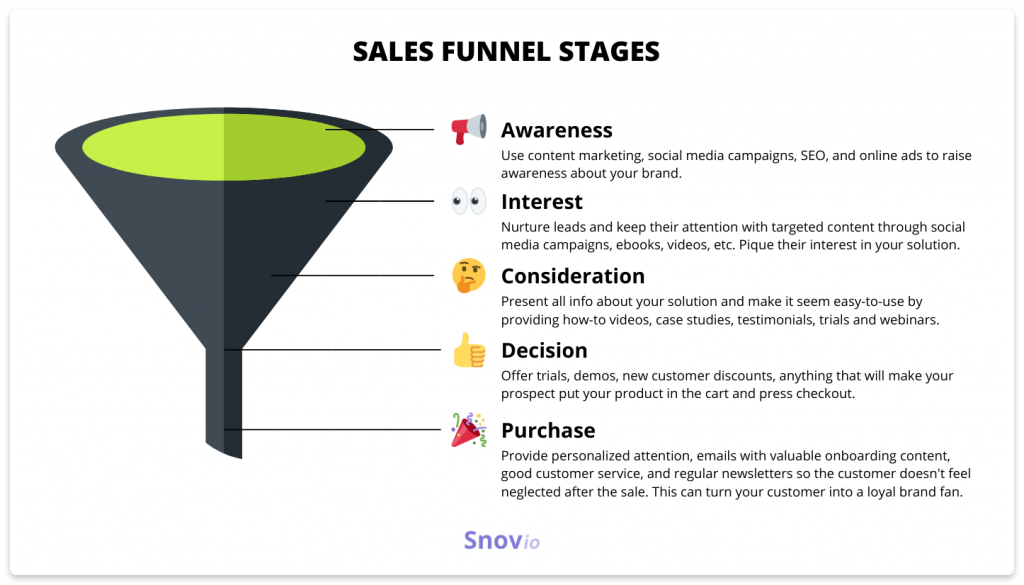Sales funnel
A sales funnel is a series of steps a lead goes through before they reach the point of buying. It’s called a funnel because out of the many people who take the first step and enter the funnel, only a few will make it through to conversion.
Putting in consistent effort in carrying your prospect from the beginning to the end of the funnel will increase your conversion rate and, subsequently, your revenue.
A sales funnel can be depicted in many ways, with the number of steps a lead goes through varying depending on the sales model. However, the idea remains the same: at the beginning of the funnel your goal is to let a lead know you exist and are offering your product/service; and by the end of the funnel, this lead, already informed and committed to purchasing your product, converts.
Sales funnel stages
Here are the most commonly defined stages of a sales funnel:
- Awareness – people have to be aware of you in order to even consider buying from you. At this step, you should invest time into content marketing, email outreach, social media campaigns, SEO, and online advertisement to get your brand out there.
- Interest – This step takes awareness to the next level. Once someone’s heard of your brand, you need to capture their interest. You need to make them realize you can provide something they need, even if they did not know they needed it. Drip campaigns, social media campaigns, and useful content such as ebooks and videos is key. Many potential customers bail at this step, so it’s important to really present your product as a solution to their problems.
- Consideration – At this point, the prospect is collecting as much information about your solution and your competitors to decide whether you are the best choice and whether they want to buy from you, if at all. Again, providing videos, how-tos, testimonials, reviews, trials, and even webinars will boost the chances of them making it to the next step.
- Decision – You’re close to a conversion and you do not want to lose this sale. Only about 5% of prospects from the awareness step make it this far. This is where you offer trials, demos, new customer discounts, anything that will make the prospects put your product in their cart and press checkout.
- Purchase – You did it! Now give your customer personalized attention, providing helpful emails, good customer service, and regular newsletters (aka nurture them) so that they don’t feel abandoned after the sale and continue buying from you. Good customer onboarding will help you not just reduce the churn rate, but also improve your customers’ CLV by acquiring loyal brand fans.
Think back to any of the online purchases you’ve made in the past, on Amazon or elsewhere, and you will see how you yourself took all of these steps before making a purchase.

Sales funnels follow a natural flow of human behavior, but as you can see, there are definitely things you can do at each step to encourage customers to the next one. These steps will apply whether your business is in goods, services, SaaS, or any other of the myriad of business models.
Why analyzing your sales funnel is important
Analyzing your results at each step can help you see where you’re making mistakes and losing valuable leads.
If you are not getting enough leads at the awareness stage, you might want to work on your SEO and content marketing to improve your lead generation.
If people are bailing at the consideration stage, work on the content that explains your solution and see how you can stand out among your competitors; testimonials and case studies also work great at this step.
If you are not getting enough repeat purchases, and you know your solution works great, look into how you organize your onboarding.
How to convert better
There are many ways to convert from awareness to consideration to decision stages, but it’s important to remember a few basics.
- Realize you are not marketing to every single person ever, you are marketing to a niche audience of people who would be interested in your product. These people have specific needs, desires, and pain points, usually described in a buyer persona. Analytics can give you a lot of information about who the people you want to reach are, so you can build your buyer persona and define your target audience based on that.
- Your content must be relevant to your target audience and their stage in the funnel. A lead at the interest stage doesn’t want to go through a demo in the same way a person at the decision stage may not need an ebook. Prepare content for each stage and distribute it accordingly.
- Don’t slack. Make sure your landing page is welcoming, your UI/UX design is great, your content is well-written, and your customer care team is prepared. Most importantly, make sure your product is at its best. You want it to be attractive and understandable.
Creating and maintaining a sales funnel is not easy but it is necessary. Take the time to improve and fine-tune it to get more sales, retain more customers, and nurture brand fans.















